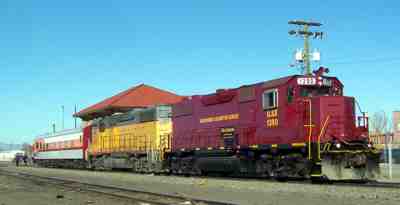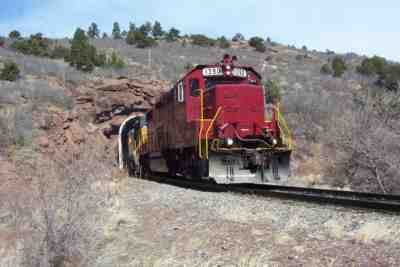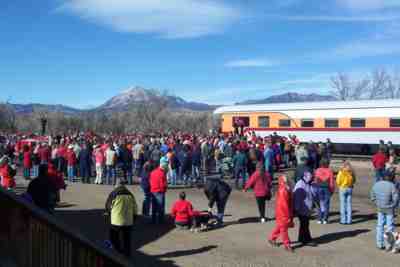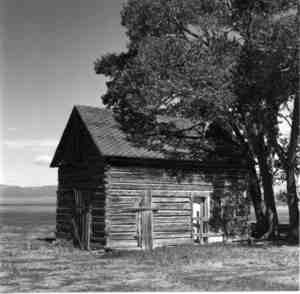Article by Ed Quillen
Transportation – March 2006 – Colorado Central Magazine
What was billed as the first passenger train since 1953 pulled out of Alamosa on the sunny morning of Feb. 9, 2006, eastbound for the town of La Veta, 61.4 miles away on the other side of the Sangre de Cristo range. The train had two diesel locomotives and only one car, the Caritas: a renovated 1948 Pullman with four private compartments, a comfortable lounge with snack service, and a rear platform where you could stand and watch the countryside recede.
This train could have been called the “Media Freeloader Excursion.” It carried reporters and railroad executives; its purpose was to publicize the regular daily trains which will start operating from Alamosa on May 24. One will follow the route we took, from Alamosa to La Veta and back over the mountains. The other will go to Antonito, where passengers can change trains and board the steam- powered narrow- gauge Cumbres & Toltec Scenic Railroad to a turn- around at Osier or the terminus at Chama, N.M.
These new passenger services developed quickly after the Dec. 22, 2005, purchase of the old Rio Grande lines west of Walsenburg by Permian Basin Railways, a short- line operator with lines in Texas, Arizona, and New Mexico. This trackage had been acquired by the Union Pacific when it swallowed the Rio Grande in 1996, and then sold to RailAmerica, which christened the Valley operation as the San Luis & Rio Grande..

Permian kept the SL&RG name. Wthin weeks of the ssale, the new passenger service was announced. Permian will operate it in conjunction with the Denver & Rio Grande Historical Foundation, which owns the 21 miles of track from South Fork to Creede, and has been accumulating equipment with an eye toward tourist operations there. But that’s another story.
La Veta, our destination, means “the vein” in Spanish, and supposedly comes from a prominent streak of differently colored rock on some cliff face in the area, but I’ve never learned just which streak is “the vein.”
It is a term that gets so much use that confusion can result. It is the name of a town and a pass. The railroad crosses La Veta Pass at 9,249 feet. This is a standard- gauge line constructed in 1899 to replace an 1877- 78 narrow- gauge line which crossed 9,386- foot Veta Pass, a few miles north of La Veta Pass. It’s a pleasant back road today, and it was the route of U.S. 160 until 1964, when the federal highway was routed over 9,413- foot North La Veta Pass. To make things more confusing, some credible accounts swap Veta and La Veta passes; so it’s easy to get confused about which is which — if anyone really knows.
Also in the same general area are Pass Creek Pass, a gravel road that comes up from Gardner, and Sangre de Cristo Pass, now on private land but used by the Spanish two centuries ago. In other words, there are quite a few ways to get from Huerfano to Rio Grande drainage.
But let’s get back on the train. Regular trains this summer will use refurbished commuter cars, not the heavy private Pullman we rode. So bear in mind that those cars will ride differently.
But the route and the scenery will be the same, and you’ll get to see a lot of new country, since much of this route is remote from any public highway. Thanks to old Mexican land grants, much of the land the route passes through, like the Forbes Trinchera Ranch, is private property, and you’ll get to gaze upon high- roller mansions as well as old sheep- loading pens.

(On this winter day, we noticed that the snowpack was sparse at the headwaters of the Huerfano River, which means another dry year downstream unless March and April bring some wet blizzards.)
The west side offers the “muleshoe curve,” where the track almost swings back on itself, and the east side hugs the mountainside while passing through two tunnels. There are stunning views of Mt. Blanca on the Alamosa side and of the Spanish Peaks near La Veta.
This is genuine mountain railroading. The east side rises from La Veta, elevation 7,041 and milepost 190.3 (they’re still using the D&RGW milepost numbers, which indicate distance from Denver) to the 9,249- foot pass (a spot the D&RGW christened “Fir”) at milepost 207.2. That’s a gain of 2,208 feet in 16.9 miles, for an average grade of 131 feet to the mile, or 2.6%. By railroad standards, that’s pretty steep — they like to keep their grades under 2%, and the west side of Tennessee Pass, where helpers were required to get most trains from Minturn to the top, averages only 2.1%.
With the Tennessee Pass line, which tops out at 10,242 feet at the tunnel apex, out of service, this is the highest through line in the United States; its closest competitor is the apex of the Moffat Tunnel at 9,239 feet — 10 feet lower. And this crossing is outdoors in the sunshine, not deep beneath the Front Range.
As for the ride, the train did rock a little, and it took me a few minutes to figure out how to walk without lurching onto a seated passenger. The track looked good — railtops shiny on top from regular use, ties evenly spaced, ballast spread smoothly — and well- maintained.
Wondering how fast we were going, I pulled out my pocket watch and timed the interval between mileposts as we started the eastbound climb from Fort Garland. It was about 2 minutes, 15 seconds, which my scribbled calculations made into 26.6 mph. A few minutes later, I noticed a speedometer in our car, next to a clock and air- pressure gauge. It read just above 25 mph, so I could have saved myself some calculating.

It’s a leisurely trip with plenty of time to enjoy the scenery and will certainly complement the other excursions offered hereabouts (on the Royal Gorge Route from Cañon City to Parkdale, and the Leadville, Colorado & Southern from Leadville to timberline).
On the Alamosa end, the big 1909 depot now holds the county department of social services, and there are no plans to return it to its earlier use. Instead, there’s a railroad building across State Street which will provide a waiting room and ticket office.
La Veta faces a bigger challenge in accommodating what everyone hopes will be scores or even hundreds of daily passengers. La Veta does have a refurbished old depot next to the tracks, but it’s now the town hall. Passengers will need a ticket office and waiting room, as well as more places to eat lunch, and the town’s public restrooms could be overwhelmed. But passengers will be able to board there; it won’t be just a turnaround for those who boarded in Alamosa.
La Veta has grown some since 2000, when it had 924 residents. But the people I talked to there sounded optimistic, and the train was certainly welcome. Hundreds of people, including the school band, greeted the train when it arrived on Feb. 9. Many were dressed in red, for it was a “red- letter day” there.
Why La Veta instead of bigger Walsenburg, which is right on an interstate highway and only 15 miles away?
When the Union Pacific sold the line, it kept a few miles on the Walsenburg end. Those tracks don’t belong to the SL&RG. UP kept them so it could control all the interchange traffic. If the SL&RG owned trackage all the way into Walsenburg, then it could also interchange directly with the UP’s main competitor in the West, the Burlington Northern Santa Fe.
That bit of hard- ball railroad tactics could turn into a tourism boon for La Veta. Meanwhile Debra Goodman, the Alamosa chamber director, couldn’t have been happier about the return of railroad passengers. Regular trains are supposed to start on May 24, just before Memorial Day weekend, and continue into mid- October. Fares and schedules are at www.alamosatrain.com.



